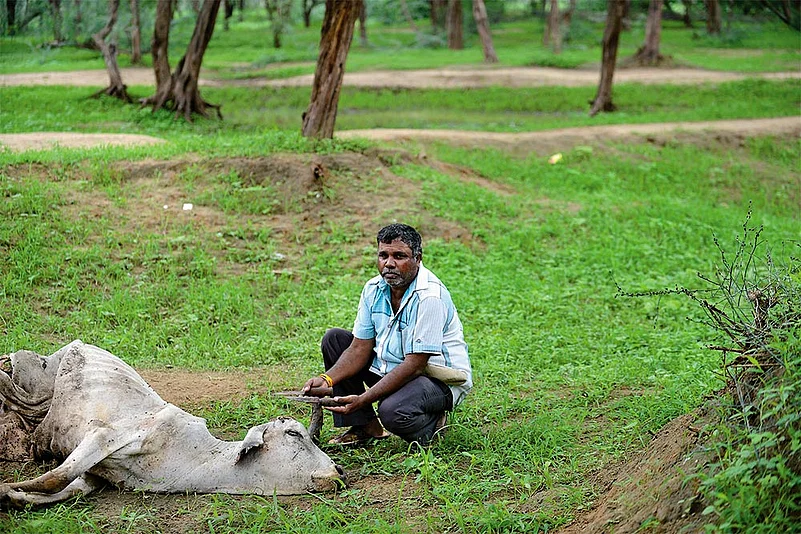History does repeat itself. In 1873, the Chandals of Bengal, who in 1911 were officially redesignated as Namasudra, called for a strike in Faridpur district, now in Bangladesh, refusing to work for other Hindus and Muslims. It is vividly detailed in a book published in 2015 by West Bengal’s Department of Backward Classes—The 1873 Movement For Dignity and Equality Before Law. The strike brought normal life to a standstill. Significantly, this was when Bengal was witnessing a ‘renaissance’, which was quite unmindful of the sufferings of untouchables.
It all began in Amgram village, where a rich Chandal, Choron Sapah, invited 10,000 men to a feast as part of his father’s shraddh ceremony. He invited people of all castes, including Brahmins and Kayasthas. The Kayasthas reportedly instigated others, and they “refused to accept the invitation, couching their refusal with taunts and reproaches”. “Eat with men who permit their women to go to the market and who are employed as mehtars in jails for removing filth and everything unclean? What next!” was the refrain.
This was reported after an inquiry conducted by the superintendent of police W.L. Owen. He noted, “The women of the poorer Chandals attend hauts and bazars for buying and selling purposes, on which account they have been despised by Hindus of the higher caste, who consider them only little better than beasts....” The insult of their women did not go down well with Chandal community leaders. The aggrieved Chandal leaders, therefore, adopted in a meeting three momentous resolutions: One, Chandal women must not in future visit hauts (haats) and bazaars. Two, Chandal men and women would not join any ‘service’ with other castes, and thirdly, food prepared by any caste other than Brahmins would not be partaken.
The strike drew the attention of the colonial administration. In a letter on March 18, 1873, Owen speculated on the impact: “If the second resolution is literally carried out, much injury will be sustained by other castes...at present fields belonging to Mohammedans and other castes are cultivated by Chandals...; these would remain untilled. Boats are built and manned by Chandals; those belonging to other castes would cease to ply and trade will be paralysed. Agricultural and domestic tools of iron would not be repaired....”
The Faridpur Chandal strike was joined by their caste brothers of adjoining Buckergunge (now Barisal) and Jessore districts. But the strikers did not resort to violence; peace and order remained undisturbed.
The district magistrate of Faridpur, W.S. Wells, reported to the government that “a large body of Hindus and Mahommedans came up to complain to me of the ruinous effects arising out of the action of the Chandals.” He recorded that the fields remained untilled, houses unthatched and not a Chandal was in the service of any Hindu or Musliman....” The magistrate warned that “they (Chandals) have always been united and this movement may become very serious”.
At its root was the government compelling Chandal prisoners to work as sweepers and clean prison toilets. The district officer in a letter on April 22, 1873, admitted, “It is a most humiliating reproach, which should be removed.... Under our law men are equal, but Chandals have no such equality if they alone are obliged to perform the most degrading duties.”
The Chandals asked: “Why were Brahmins, Kayasthas, Sudras and Mussulmans exempted from the dirty work in jails?” The strike of 7,54,323 Chandals in three districts continued for six months. Lieutenant-governor of Bengal Sir George Campbell issued orders to the effect that “the Chandals in jail should not be forced to do the work of sweepers....” (vide letter no. 523T, June 7, 1873).
Dalits and tribal communities form over 23 per cent of India’s population, though they are denied justice and dignity by Hindu elite castes. Their refusal to dispose carcasses and clean streets is a potential nightmare. Together, this makes a formidable force that promises the road for their emancipation.
(The author, a retired IAS officer, is former vice-chancellor, Ambedkar University, Muzaffarpur)
Slide Show
This first totally non-violent strike in 1873 is barely recognised in historiography. Gandhi was an infant then, and Tolstoy’s writings on non-violence, which so influenced him, came out only in 1896.
















